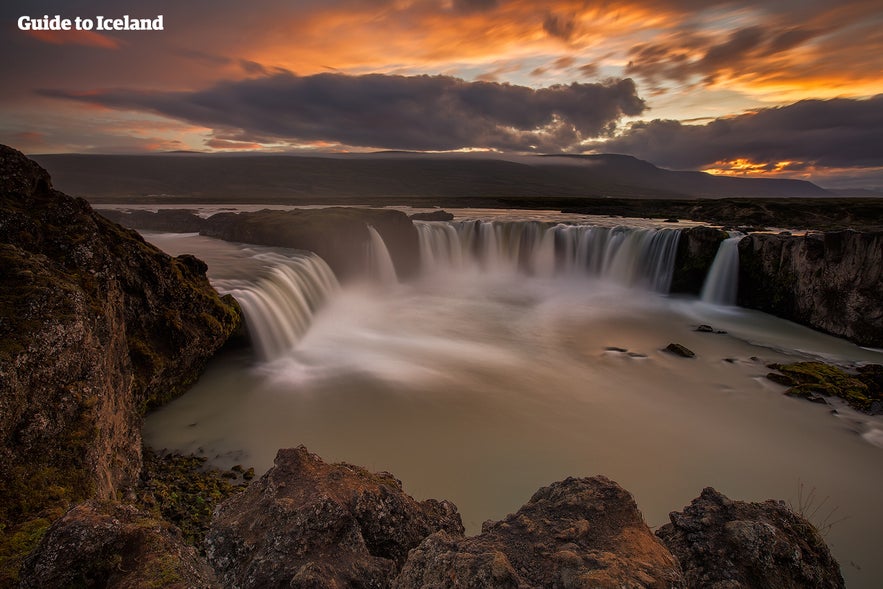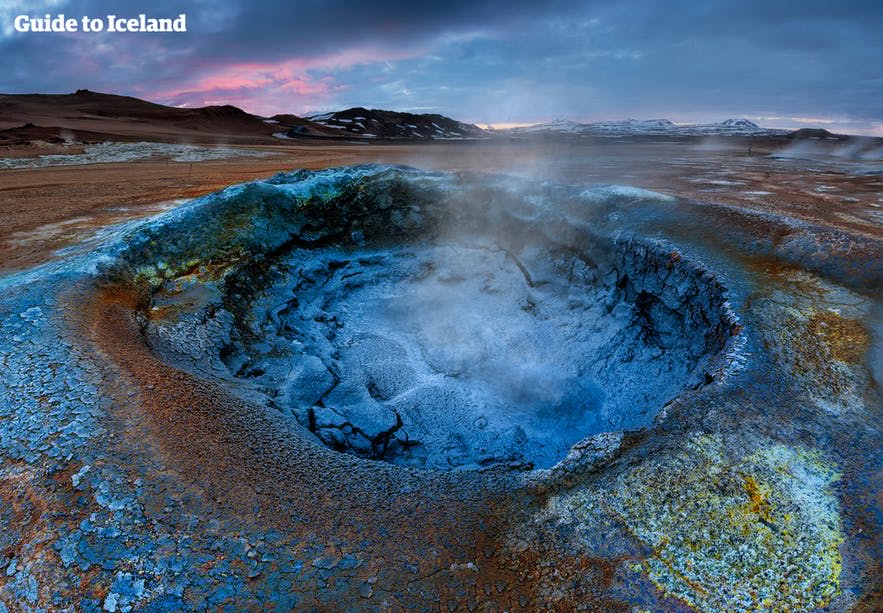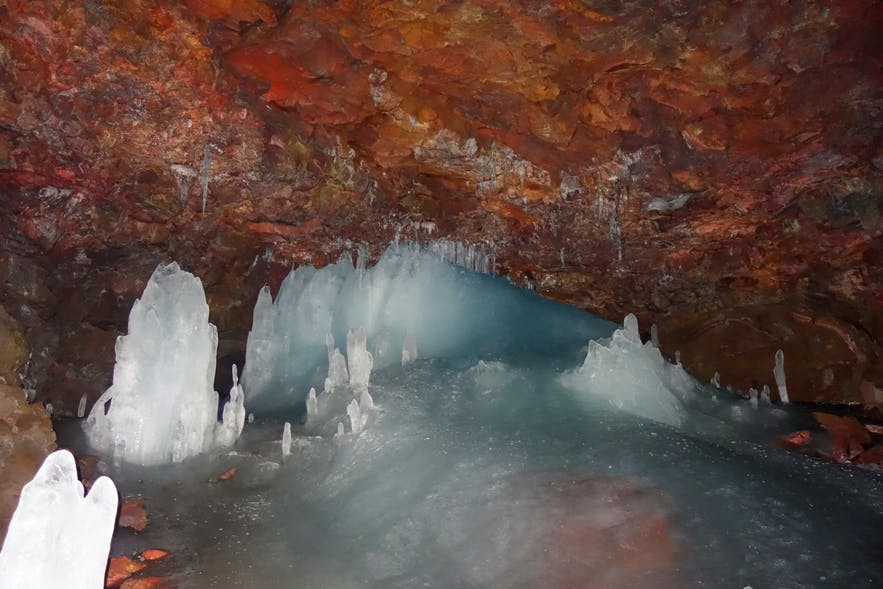
The Ultimate Guide to Lake Myvatn

- Geology and Nature of Lake Myvatn
- Biology of Lake Myvatn
- What is the Diamond Circle?
- Top Locations at Lake Myvatn
- Myvatn Nature Baths
- Namaskard Geothermal Area
- Dimmuborgir Rock Formations
- Hverfell Crater Mountain
- Skutustadagigar Pseudocraters
- Grjotagja Hot Spring Cave
- Viti Crater in Krafla Volcano
- Lofthellir Cave
- Should I Visit Lake Myvatn in Summer or Winter?
- Staying Near Lake Myvatn
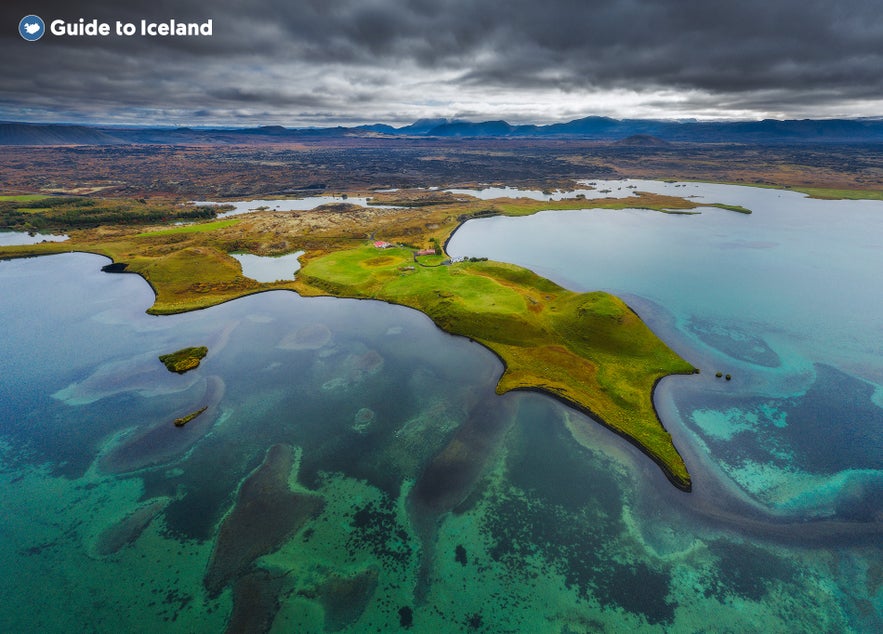
What makes the Lake Myvatn area so special? Are there any other sites in north Iceland near Lake Myvatn? Should I visit Lake Myvatn in summer or winter? Read on for all the answers!
North Iceland is home to the lake region of Myvatn, a location many locals consider the most beautiful in all of Iceland. This natural wonder was created as a result of a massive basaltic eruption, and as a result, Lake Myvatn is now home to incredible geological features as well as a wealth of flora and fauna.
The lake's surroundings are dotted with diverse volcanic landforms of unbelievable beauty, including pseudocraters, lava pillars, lava fields, and hot springs. These sites are not only stunning to look at but also grant valuable insight into the raw natural forces that shaped Iceland's unique landscape.
Lake Myvatn is one of the highlights of the Diamond Circle, a popular travel route in northern Iceland. There are many Diamond Circle tours and Myvatn tours to choose from, where you can explore different parts of this magical region along with a knowledgeable local guide. Maybe you'd prefer exploring the region on your own on a self-drive tour and staying at one of many great accommodations in Myvatn. The choice is yours!
In this article, we'll go over the main things you should know about Lake Myvatn, including the best locations and tours to see in this remarkable area.
- Find out What to Do & Where to Go in Iceland
- Get to know Iceland's volcanic nature by reading about Geothermal Areas in Iceland
Geology and Nature of Lake Myvatn

Lake Myvatn came into existence approximately 2,300 years ago as a result of a large basaltic lava eruption. As the lava flowed into the region, it encountered wetlands and other lower-lying areas. The interaction between the hot lava and the water resulted in steam explosions, which created a series of distinctive features, including the pseudocraters that can be found in the area.
The lava flow also blocked the natural drainage paths of the area. This obstruction by the lava dammed up the water, which led to the formation of Lake Myvatn itself. Today, Myvatn is one of the largest lakes in Iceland, covering an area of approximately 14 square miles (37 square kilometers). The lake is, however, quite shallow, with an average depth of about 8 feet (2.5 meters).
Biology of Lake Myvatn
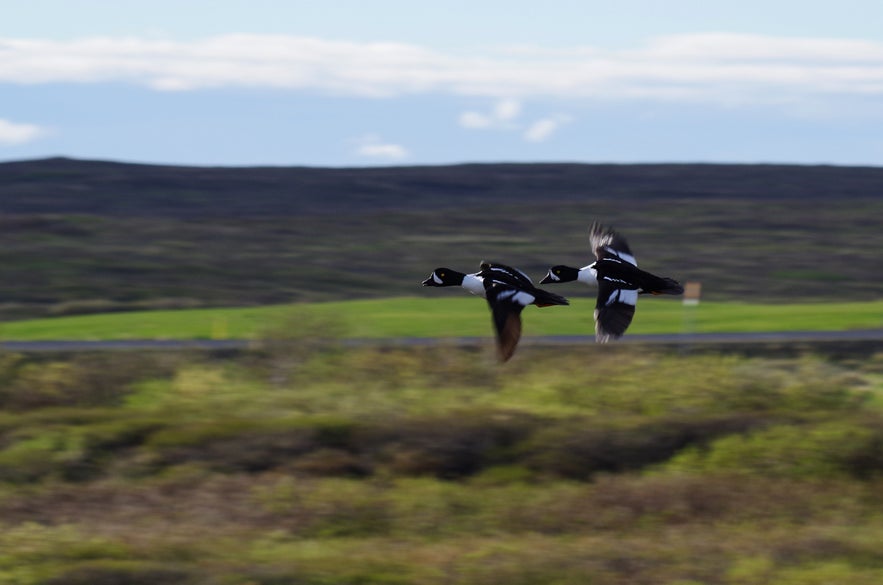 Lake Myvatn is renowned for its rich flora and fauna, largely stemming from the fact that the lake is pretty shallow and has rich sources of energy and nutrition. The name 'Myvatn' translates to 'Midges Lake,' and midges are probably the first animal you'll notice surrounding here if traveling in summer.
Lake Myvatn is renowned for its rich flora and fauna, largely stemming from the fact that the lake is pretty shallow and has rich sources of energy and nutrition. The name 'Myvatn' translates to 'Midges Lake,' and midges are probably the first animal you'll notice surrounding here if traveling in summer.
The presence of midges in the lake is a large reason for the rich birdlife found at Lake Myvatn, which is known for its abundance of duck species. The rich supply of aquatic insects, especially midges, provides a valuable food resource for the ducks during certain periods.
- See also: Birds in Iceland
Most of the ducks in Lake Myvatn are migratory, arriving in spring from northwestern Europe. The most common species are the tufted duck and the greater scaup, but other species include the barrow's goldeneye, the northern shoveler, and the mallard. A bird museum can be found in the area, Sigurgeir's Bird Museum, which has a specimen of every Icelandic breeding bird there, except one, the Grey Phalarope.
 There is also a great variety of intriguing plant life to be found in Lake Myvatn, including the marina, a species of green algae that forms into large, velvety balls. Colonies of this peculiar lifeform are native to very few places in the world outside of Myvatn but have been discovered in Japan, Scotland, Estonia, and recently in Australia.
There is also a great variety of intriguing plant life to be found in Lake Myvatn, including the marina, a species of green algae that forms into large, velvety balls. Colonies of this peculiar lifeform are native to very few places in the world outside of Myvatn but have been discovered in Japan, Scotland, Estonia, and recently in Australia.
- See also: Plants in Iceland
In the mid-20th century, there was a significant decline in the marimo population in Lake Myvatn because of environmental reasons, causing the colonies to disappear. The lake's ecosystem is now improving, and small marimo balls are forming again.
What is the Diamond Circle?
Lake Myvatn is part of a sightseeing route named the Diamond Circle which also visits the town of Husavik, the canyon of Asbyrgi, and Dettifoss waterfall. Other attractions visited on certain tours include Godafoss waterfall and the Hljodaklettar rocks.
The town of Husavik is known for being the whale-watching capital of Europe, with many operators boasting 100% success in their sightings over the summer. It's also a very picturesque and colorful little town in its own right, with beautiful views across the bay of Skjalfandi.
Asbyrgi, meanwhile, is a magnificent horseshoe-shaped canyon filled with a lush green forest. Nearby are the stunning Hljodaklettar rock formations, where basalt columns run in every direction.

Dettifoss is the second most powerful waterfall in Europe, thundering into a haunting black ravine. Godafoss waterfall is less powerful but notable for its history; it is named 'the waterfall of the gods,' as it was supposedly here where Icelanders officially converted to Christianity over a millennium ago.
If you want to visit Lake Myvatn and these surrounding attractions, you can take a day tour of the Diamond Circle from Akureyri. This is suitable for those who have limited time in the area and want to tick off all the major sights.
- See also: The Ultimate Guide to the Diamond Circle
Migliore Tour self drive in Islanda
Tour di 7 giorni dell'aurora boreale in autonomia con auto a noleggio attraverso il Circolo d'Oro e l'Islanda meridionale
Self-drive 10 giorni con l'intera Ring Road dell'Islanda, le attrazioni migliori e Snaefellsnes
Incredibile tour self drive estivo di 1 settimana lungo la Ring Road dell'Islanda con il Circolo d’Oro
Top Locations at Lake Myvatn
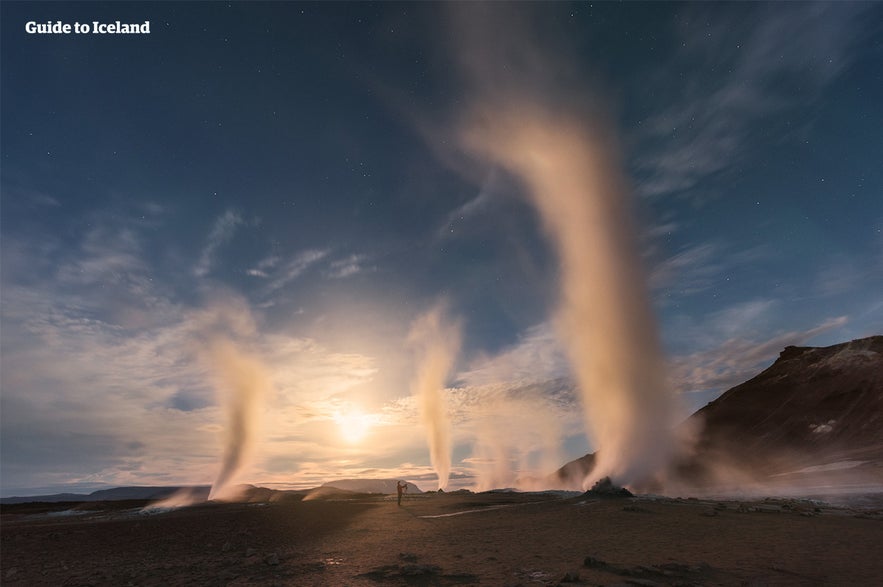 With the surroundings and general conditions out of the way, let's get into specifics. There are many things to see in Lake Myvatn, from geothermal areas to lava formations and relaxing spas. Let's go over a few.
With the surroundings and general conditions out of the way, let's get into specifics. There are many things to see in Lake Myvatn, from geothermal areas to lava formations and relaxing spas. Let's go over a few.
Myvatn Nature Baths

If you have come to Iceland hoping to go hot spring bathing, then don't miss your chance at the Myvatn Nature Baths. This pristine pool is surrounded by incredible nature and heated by the geothermal forces of the area.
The baths are centered around a large lagoon, which has a temperature of about 97 to 104 degrees Fahrenheit (36 to 40 degrees Celsius). Book your admission to the Myvatn Nature Baths to experience their water, which is packed with minerals that are good for respiratory and skin problems.
In addition to the main bathing lagoon, the complex offers steam baths that harness geothermal steam from the ground below. The facilities are rounded off with a restaurant offering refreshments and local cuisine. In wintertime, it's the perfect place to admire the Northern Lights in Myvatn, but the views are magnificent on sunny days as well.
Namaskard Geothermal Area
Namaskard Pass, on Mount Namafjall, is a stark geothermal area, defined by its seething fumaroles and brightly colored clay, that is worth a visit on any trip to Myvatn. With the barren landscapes, sulphuric smells, and swirling steam, walking here makes it feel like you have entered another world.
Hours can be spent marveling over the contrasts of the colors and listening to the hissing and bubbling sounds of the earth. Be sure to stick to the paths in this area, as the earth around the vents is unstable and often full of boiling water.
The alien-like landscape of Namaskard Pass helps to illustrate how dramatically diverse North Iceland is. Myvatn and its surrounding rich vegetation is only on the other side of the mountain! You can explore this area on a sightseeing tour from Akureyri.
Dimmuborgir Rock Formations
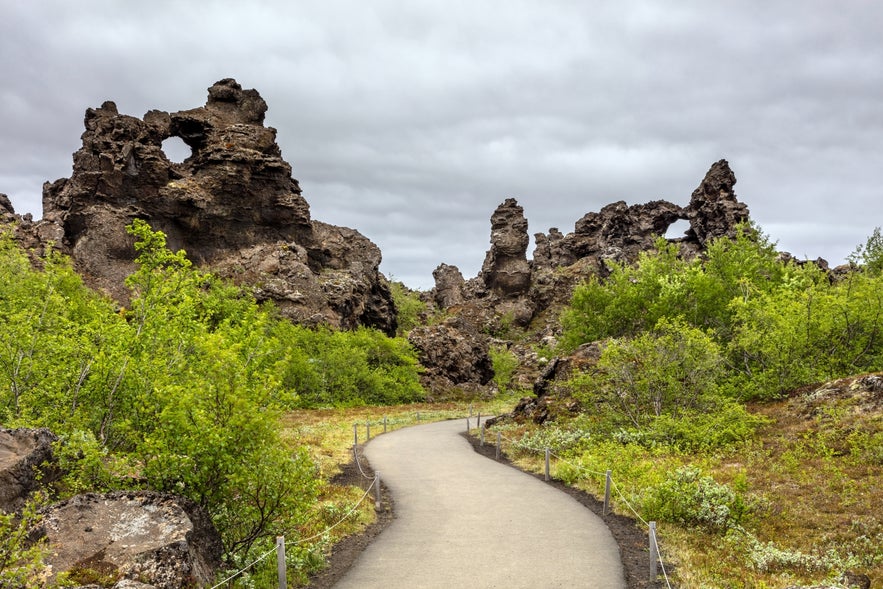 Dimmuborgir, or the Dark Fortress, is an area of dramatic lava rocks just east of Lake Myvatn. Often compared to a castle, it has columns that resemble towers, ridges that rise like battlements, and caves that tumble deep into the earth like dungeons. There are several hiking trails in the area that take from just a few minutes up to a few hours and are suitable for people of all abilities.
Dimmuborgir, or the Dark Fortress, is an area of dramatic lava rocks just east of Lake Myvatn. Often compared to a castle, it has columns that resemble towers, ridges that rise like battlements, and caves that tumble deep into the earth like dungeons. There are several hiking trails in the area that take from just a few minutes up to a few hours and are suitable for people of all abilities.
The shortest route is paved, so it is easily accessible for those in wheelchairs or those who have trouble walking. It only takes about 10-15 minutes and leads you to the holes in the rocks seen above. If you want to head a bit further, then the trails turn to gravel or earth, and you can spend hours admiring the fascinating landscape.
There are several folk stories from this area, and it's easy to see how people could've mistaken the rocks for mysterious creatures, especially considering there used to be no trails through this rock labyrinth, and Iceland is often dark and foggy. Discover this area on a 4x4 tour of the north coast.
Hverfell Crater Mountain

Locals disagree on the spelling of Hverfjall, and it can either be called Hverfjall or Hverfell. Both have the same meaning: Crater Mountain. Regardless, it is one of the most popular hiking destinations in the Myvatn area, as it can be fully ascended and encircled.
There are two permitted routes to get to the top of the mountain: the easier one from the parking lot right by it, while the more challenging one (that takes approximately 45 minutes) starts from Dimmuborgir. Walking off of either of these paths is not permitted. Hiking around the crater itself takes about an hour.
The mountain sticks boldly from the surrounding landscape, towering over green fields of mossy lava, but it is only around 1370 feet (420 meters) tall. Seeing as the mountain isn't very high, hiking to the top is not difficult and can be done by those with a low level of fitness and by young children, making it a perfect family activity.
Skutustadagigar Pseudocraters
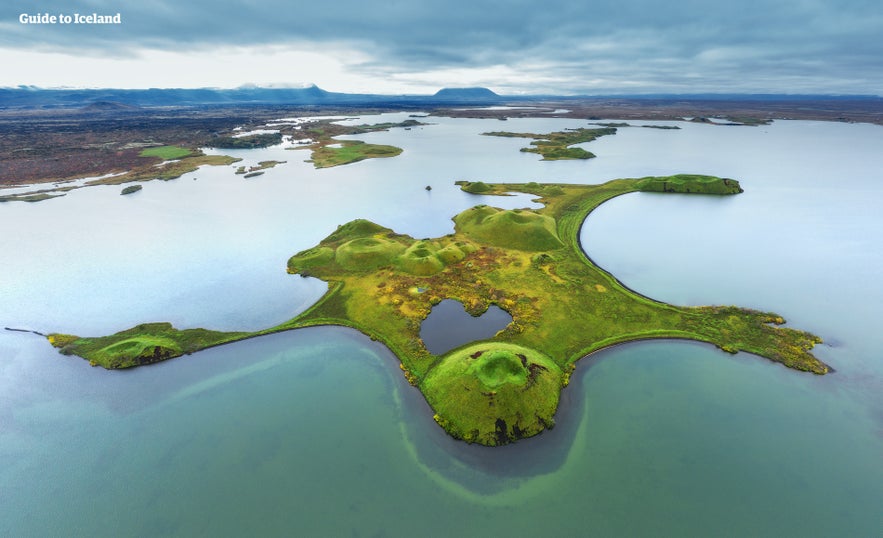
On the southern side of Lake Myvatn is a set of features collectively called Skutustadagigar, a row of bizarre and beautiful pseudocraters. Unlike regular craters, which are formed when lava builds up around a fissure in the earth, these pseudocraters were formed by gas explosions when melting lava flowed over pockets of water in the wetlands.
The area is now protected as a conservation area, but you can still hike through it and walk up the slopes for some fantastic views. Skutustadagigar is particularly popular amongst birdwatchers due to the number of duck species that nest in the area.
Grjotagja Hot Spring Cave
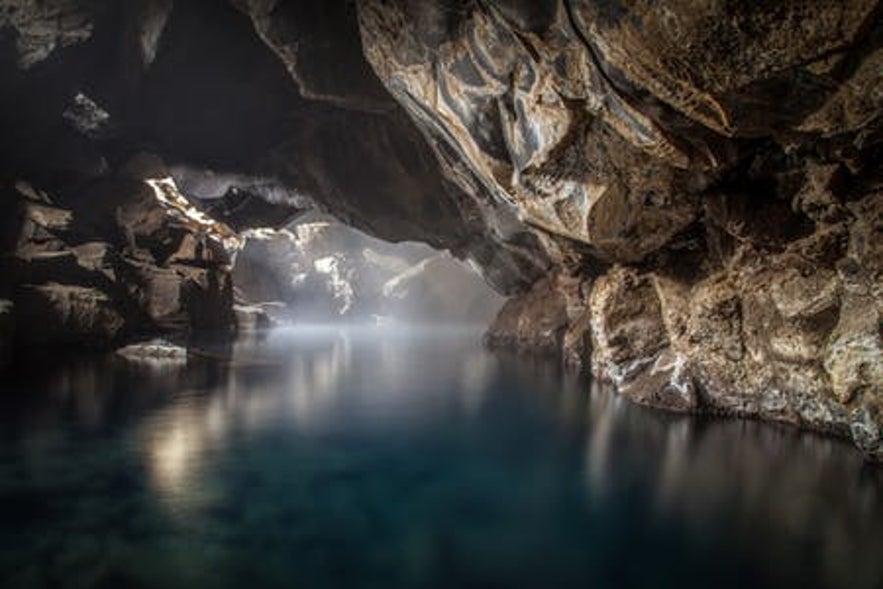
Photo by Andrés Nieto Porras
Grjotagja is a small geothermal hot spring hidden within a rugged lava cave in Dimmuborgir. This hot spring is renowned for its pristine beauty and azure waters, which shimmer invitingly in the dim light filtering through the cave's opening.
While Grjotagja historically served as a bathing spot, the temperature of the waters increased during volcanic eruptions in the latter half of the last century, making it unsuitable for bathing. Grjotagja is still well worth visiting due to its beauty and the boldness of its color.
Grjotagja found its fame after being used in an iconic love scene in Game of Thrones, although in Westeros, they added a waterfall with CGI, and the water was warm enough to swim in, which it is not here.
Viti Crater in Krafla Volcano
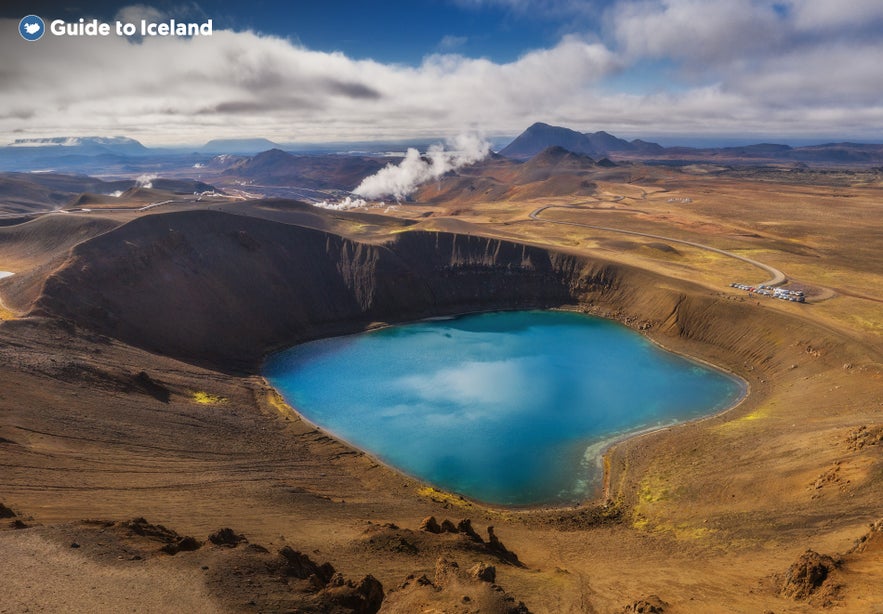
Two craters in Iceland go by the name Viti, one by Krafla in the Lake Myvatn region and another by Askja in the Highlands of East Iceland. Both Krafla and Askja are some of the most well-known volcanoes in Iceland and are impressive sights to see. Both Viti lakes are located at the bottom of a crater by each of the central volcanoes.
The water in Viti by Krafla is of a stunning aqua-blue color, sometimes in shades of green. In winter, it is often surrounded by snow despite the hot geothermal areas nearby. It is located a short distance north of Namaskard.
There have been 29 volcanic eruptions in Krafla in recorded history; the last one ended in 1984 after going on for 9 years. As a result, there are stunning lava formations to be seen all over the area.
- See also: Volcanoes in Iceland
Lofthellir Cave
Picture by Regína Hronn Ragnarsdottir
East of Lake Myvatn is the otherworldly Lofthellir cave, renowned for its spectacular icicle formations. The beauty of this cave is in its contrasts of the red lava rock ceiling and the white ice, with its hints of electric blue.
This cave is about 3,500 years old and 1200 feet long (370 meters). The temperature inside the cave stays at around freezing year-round and is not suitable for those with claustrophobia, as some crawling is necessary to enter. Be sure to dress warmly before going, and only go with a tour guide, not on your own.
Conditions in the cave vary, and tours are only offered between May and October.
Should I Visit Lake Myvatn in Summer or Winter?
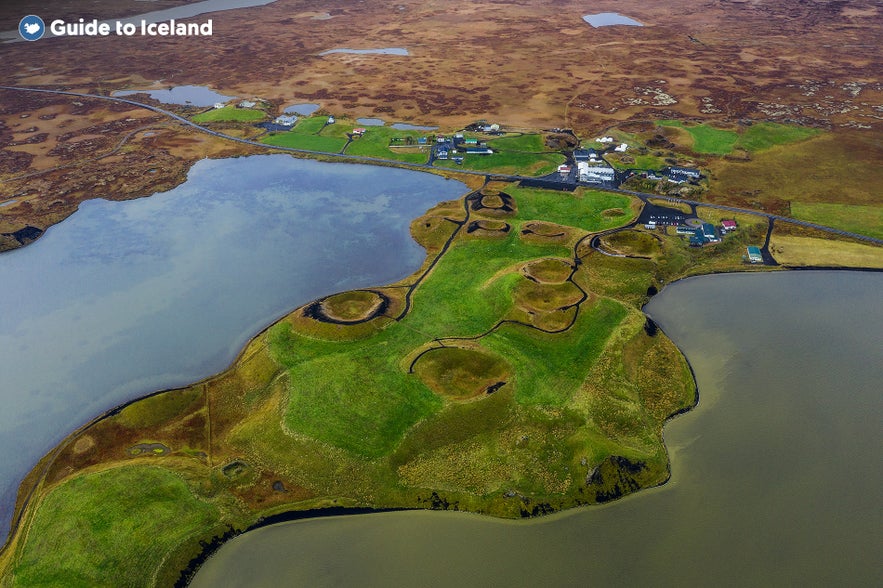 Whether you should visit Lake Myvatn during the summer or the winter largely depends on your personal preferences and the kind of experiences you're looking to have.
Whether you should visit Lake Myvatn during the summer or the winter largely depends on your personal preferences and the kind of experiences you're looking to have.
During the summer months, you can experience the Midnight Sun, offering extended hours for sightseeing and outdoor activities. This period is prime for birdwatching, and the surrounding landscape becomes vibrant and green, dotted with blooming wildflowers.
The trails, leading to attractions like the Dimmuborgir lava formations and Skutustadagigar pseudocraters, are more accessible. And while temperatures remain on the cooler side, they are generally milder compared to the winter months, making outdoor exploration more comfortable.
Picture from Unforgettable 2-Hour Siberian Husky Dog Sledding Tour in the Myvatn Area
On the other hand, the winter months offer their own unique allure. One of the standout experiences is the chance to witness the mesmerizing Northern Lights, with the dark skies around Lake Myvatn serving as an ideal canvas for this natural spectacle.
Another great opportunity arises in the winter month: dogsledding! This fun activity is available from a farm just south of Lake Myvatn during the winter months. It is an ideal activity for animal lovers and families with young kids, especially since the age limit for the dog sled is just two years old. Try it out for yourself on an incredible 2-hour dogsledding tour with Siberian Huskies.
If extended daylight, birdwatching, and hiking are priorities, summer offers a rewarding experience. Winter is your best bet if you're drawn to the idea of a snow-clad landscape and the magical Northern Lights. Both seasons are distinctively charming, so your choice should be based on the activities and experiences that resonate most with you.
Staying Near Lake Myvatn
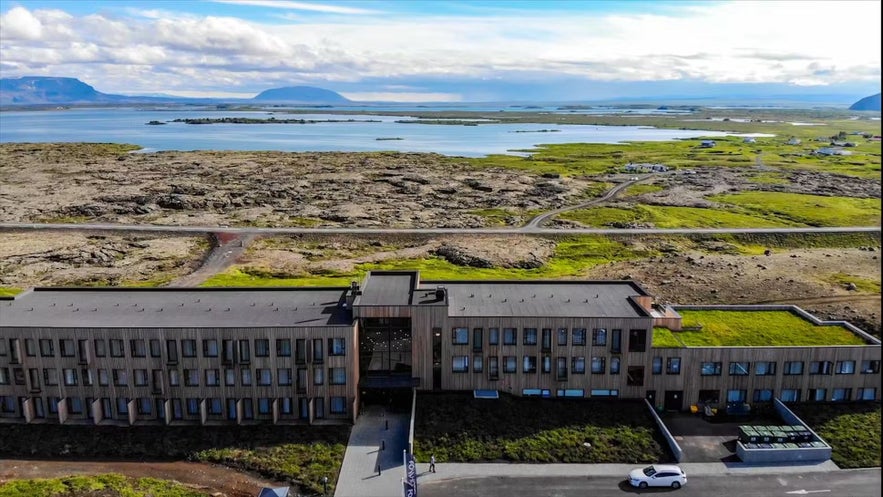 There are several fantastic hotels and accommodations at Myvatn, as well as a campsite and various cottages that can be rented out. Whether you choose to stay in a comfortable hotel or a quaint bungalow just comes down to preference and what you're looking for.
There are several fantastic hotels and accommodations at Myvatn, as well as a campsite and various cottages that can be rented out. Whether you choose to stay in a comfortable hotel or a quaint bungalow just comes down to preference and what you're looking for.
Fosshotel Myvatn, pictured above, is located in a prime location overlooking Lake Myvatn. There, you will find top-end amenities and maximum comfort, along with a fantastic view of the lake. The Myvatn Nature Baths are located just a few minutes' driving distance away, which is very convenient if you want to take a relaxing soak. Book a table at the hotel restaurant for an unforgettable meal.
The guesthouse Vogafjos is another great option, located on the shores of Lake Myvatn. This secluded accommodation offers rustic yet luxurious rooms with Icelandic delicacies sourced from local ingredients that are available at the guesthouse cafe.
- Check out the Best Restaurants in North Iceland
Did you enjoy our ultimate guide to Lake Myvatn? What will you do when you visit Lake Myvatn? Tell us in the comments!
Altri articoli rilevanti
La guida completa della laguna glaciale Jokulsarlon, in Islanda
Scopri tutto ciò che devi sapere per organizzare un viaggio alla laguna glaciale Jokulsarlon, nell'Islanda sud-orientale. Si tratta di una delle attrazioni più famose del paese, per via della bellez...Leggi altroVisitare l'Islanda a ottobre | Cosa fare e cosa visitare
Scoprite le migliori cose da fare e i luoghi da vedere in Islanda a ottobre. Con tutto quello che c'è da sapere sul clima in autunno, su come muoversi, su cosa mettere in valigia e su quali tour int...Leggi altroLa guida completa dell'Islanda a dicembre
Scoprite le migliori cose da fare in Islanda a dicembre. È uno dei periodi migliori per visitare l'Islanda grazie alle eccellenti condizioni per l'aurora boreale e allo spirito festivo del Natale. Sc...Leggi altro

Scarica il più grande mercato di viaggi in Islanda sul telefono per gestire l'intero viaggio da un unico posto
Scansiona questo codice QR con la fotocamera del telefono e premi il link che compare per avere sempre in tasca il più grande mercato di viaggi in Islanda. Inserisci il numero di telefono o l'indirizzo e-mail per ricevere un SMS o un'e-mail con il link per il download.
